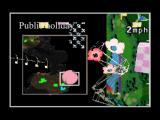Klik & Play, being a 1994 release, was developed back in the Windows 3.1 era. This means that it is a 16-bit application. With Windows 95, there was backward compatibility with 16-bit applications in the new 32-bit environment, so for many years, Klik & Play ran happily (most of the time, anyway). However, we are now facing a transition to 64-bit. The 16-bit capability is still available on 64-bit x86 processors - you can thank AMD for that. However, 64-bit versions of Windows do not include the Virtual DOS machine needed to run 16-bit applications. So effectively, no Klik & Play.
Fear not, however, for you can still use your beloved Klik & Play. Documented here are several ways to get Klik & Play back.
Using XP Mode
If you are running on Windows 7 Professional or Ultimate, you are entitled to use 'XP Mode'. With this method, you download a real (albeit somewhat trimmed down) image of Windows XP off of Microsoft's website, and virtualize it using Virtual PC. A big advantage to this method is that you get very nice system integration.
- Check to see if your processor is capable of hardware virtualization. It's not necessary, but it can be very helpful. Almost all newer AMD processors (that aren't entry-level) have this capability. With Intel, coverage is a bit spotty.
- If you have hardware virtualization, reboot and enter the BIOS, and check to see that the feature is enabled. Then boot back into Windows.
- Go here to download and install XP Mode. You need the first and second items. If you do not have hardware virtualization, you need to download the third item. Otherwise, you don't need to worry about it.
- Grab a beer while you wait for XP Mode to download and install.
- Start XP Mode and install Klik & Play.
- Do a little jig.
To run Klik & Play games from XP Mode, simply double-click on a .gam file from the file manager in Windows 7. The virtual machine will automatically start up, and the window will appear on your desktop in seamless integration mode, which is very handy. This makes for two ways of starting XP Mode: in "full" mode, accessible from Start -> All Programs -> Windows Virtual PC -> Windows XP Mode, and in seamless integration mode, from a lone application shortcut (XP Mode will place one for Klik & Play in the Start Menu), or opening a file from the shell.
Since viruses and badware can affect the virtualized XP, you may want to install (basic) virus protection, and avoid giving XP Mode access to your C: drive (in "full" mode, go to Tools -> Settings -> Integration Features).
Due to an oversight by Microsoft, the display will only update at a slow rate unless the virtual machine is receiving input from the mouse or keyboard, as an optimization running under the assumption that the only purpose of Virtual PC is for business applications! Obviously, if you're using Klik & Play, this isn't what you want. There is a workaround for this, however. Download Autohotkey, then create an .ahk file somewhere on your hard drive, and put this in it:
Loop {
MouseMove, 0, 1, 0, R
MouseMove, 0, -1, 0, R
}
Now run the script with Autohotkey and your mouse will vibrate in place. It's a messy workaround, but it gets the job done.
Using Dosbox
- Install DOSBox.
- Follow this guide to installing Windows 3.1 on DOSBox. Make sure you install the S3 video drivers and the Sound Blaster sound drivers for maximum awesome.
- Download Klik & Play, and install it under Windows 3.1 running inside DOSBox.
- You're good to go!
Klik & Play on (64-bit) Linux
Wine is capable of running 16-bit applications to some extent, even when running on the x86_64 architecture. Klik & Play runs, but crashes out or displays an error about memory when any attempt is made by Klik & Play to display the game screen. This happens when attempting to open the Frame Editor and when launching finished games. This error might provide some insight:
err:dc:CreateDCW no driver found for L"DIB"
Wine, by default, does not include a DIB engine (which plays a role in updating graphics to the screen in some programs). Further investigation is necessary, but may yield positive results.





